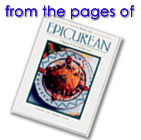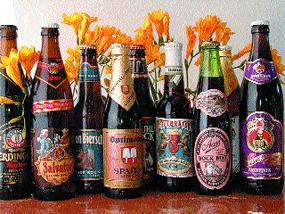
 |
|||||
|
|
|
|
|
|
|
The Pleasures of Bockby Paul Etcheverry |
|
 To some, it's the unmitigated nectar of the gods - as if there was a mitigated nectar of the gods. To others, it's the dregs from the bowels of a moldy beer barrel, the rankest slime since grainy arachnids hovered behind a resolutely square-jawed Peter Graves in 1950's monster movies.
To some, it's the unmitigated nectar of the gods - as if there was a mitigated nectar of the gods. To others, it's the dregs from the bowels of a moldy beer barrel, the rankest slime since grainy arachnids hovered behind a resolutely square-jawed Peter Graves in 1950's monster movies.
In Germany - a country that brought us Bertolt Brecht, Kurt Weill, Fritz Lang and the Third Reich in the same cosmic instant - it's as traditional as chowing down on a bratwurst while firing up "A Little Night Music." Yet in Belgium and England, world brewing centers that lure ale aficionados like the Holy Lands draw pilgrims, they don't even make the stuff. And in the U. S. of A, it's been exponentially gaining favor each year since resourceful brew-it-yourself renegades emerged from their garage brauhauses, backpacking retreats and bicycle repair shops to revive the great American tradition of independent and regional breweries. I wax marginally poetic over a thick, sweet, tawny, malty, chocolatey, delicious and decadent mouthful of a brew known as bock beer. Sometimes it's syrupy enough to dribble on French vanilla ice cream. At other times, a creamy bock can be as smooth as an expensive silk shirt. And please, just disregard the fact that the venerable brew's traditional symbol is the Billy goat, arguably the most repulsive creature on earth next to the humble dung beetle. Just what is a bock beer, anyway? Is it the crud from the bottom of fermentation vessels? No way - this remains strictly a much-spoken myth (a good thing, since there just isn't much of a market for sediment as a beverage). While "bock" comes in a variety of colors and styles, this essentially refers to a malty, big-bodied lager beer, made with a bottom-fermenting lager yeast and aged at cool temperatures (usually not above 46° F). Its hues range from rich amber and deep copper to a stout-like brown. More often than not, the operative word for a thick and frequently sweet bock beer is "strong." German law decrees that bock beer possess a gravity of 1.066, 5.3% alcohol by weight, 6.7% by volume. The hefty Doppelbock or Double Bock style must exceed 1.074 - but in Bavarian brewmaster practice, this is the equivalent of a 225 pound offensive lineman. The ridiculously potent Eisbock weighs in at a whopping 12+% alcohol by volume and a specific gravity topping 1.100.
The brew's intensity reflects its origins as Europe's first widely exported beer. Bock beer originally hailed from Einbeck, in the German state of Lower Saxony, a place where brewing - in a rare departure from the norm - was not the exclusive domain of royals or monastics. While it's impossible to know just what an Einbeck beer tasted like 600 years ago, the malty libation played a vital role in the thriving commerce that characterized the Hanseatic League, the 14th and 15th centuriesÕ consortium of ports and trade centers. And the beer from what was arguably the first "brewing city" on record had to, without a doubt, be of industrial strength to survive long journeys. One of those journeys delivered the coveted brew to the wedding of no less a figure than Martin Luther, leader of the Protestant reformation. Reputedly, Luther was given Einbeck beer in 1521 to lift his spirits through the scathing reprimands and denunciations of the Emperor, when he appeared before the infamous Diet of Worms. Whatever happened, it was not lost on the brewery's marketers - centuries later, the brewery even featured Luther's visage on their Ur-Bock labels. Even more essential to the spread of this style in the 16th century was the wedding of royalty from Lower Saxony to a belle of Bavaria. Thus, the seeds were planted for the spread of Einbeck-style brewing techniques through Southern Germany. It was not long before the beloved bock evolved into the traditional Teutonic springtime beer, the subject of May Day ceremonies. Without further adieu, here are the classic styles of bock beer, what they're about, why I'm singing their praises. HELLES BOCK This lovely, malty, deep gold to amber style is truly something of a close relation to the classic Munich Helles lager, albeit maltier and higher in gravity. The German versions tend to be rich and thick. One excellent example of the style is Einbecker Ur-Bock, from the city that started it all. A robust amber lager, with a multi-layered malt body and tangy Hallertau hops in support, it's substantial, but not overbearing in any way. Another good Bavarian Helles Bock, available seasonally, is Spaten Franziskus. A rare bock from Czechoslovakia, Lev Lion Palebock, imbues the malty style with their native Saaz hops, the soft, delicate and fragrant flowers best known as the cornerstone of the country's renowned world classic, Pilsner Urquell. Some excellent American renditions of helles bock - Gordon Biersch Blonde Bock, and Sierra Nevada Pale Bock - present a refreshing hoppy dryness that aptly balances that sumptuous mouthcoating character. And while there are tasty but significantly less meaty versions of "the blonde bock" in the Americas (Michelob Amber Bock, CincinnatiÕs Ludwig Hudepohl Bock), most helles bock beers are strong, weighing in at a hearty specific gravity of 1.066+. |

MAIBOCK Made to celebrate May Day, here's an even maltier version of hellesbock, thick, chewy, in some cases fruity and estery - one doozy of a Munich lager (drat, I'm thinking of sausages already). Such renowned Bavarian breweries as Ayinger and Paulaner produce excellent versions of the style, and have exported them to the U.S. It's a fair assumption that many more small breweries in the region make special extra-malty amber brews for Maytime consumption. In addition, a few German breweries from outside Bavaria (Herforder, Holsten, and, of course, Einbecker) offer maibocks. If your travels take you to Bavaria on May 1, don't miss the annual tapping of the first gargantuan maibock barrel at Munich's Hofbrauhaus! Here, you can sample the Real McCoy, described by Michael Jackson in The World Guide To Beer as possessing "an aroma so powerful that it can almost be eaten." DOPPELBOCK This Easter-time brew, also known as Double Bock, is arguably the style most associated with the word "bock" - and the one I had in mind mentioning such words as tawny, creamy, toffee-like and chocolatey. In The Beer Enthusiast's Guide, Gregg Smith termed it "very full-bodied with intense malty sweetness and aroma." Its specific gravity begins at 1.074; its alcohol level at 6% by weight, 7.5 % by volume. Doppelbock originated via the of the monks of St. Francis of Paula, whose considerable expertise was comparable to the master monastic brewers of Belgium. Back in 1634, they developed this outstanding brew for consumption during Lent and dubbed it Salvator (Savior), inadvertently starting a world trend in brewing; their competition soon would be paying homage with their own dark brown doppelbocks, all with names ending in "ator." Maximator (from the Augustiner brewery), Animator (Hacker-Pschorr), Fortunator (Ayinger), Optimator (Spaten), Kulminator (EKU) are just a few of the 100+ double bocks brewed in Germany. The style also enjoys popularity in the Netherlands and Norway (Aass Bock, from Drammen, offers a tasty example of a Norwegian rendition of the double bock style). Paulaner Munich still brews its splendidly hefty, burnt-coffee-toffee flavored Salvator, annually celebrated by the "springtime tapping of the first keg" at its 3,500-seat beer hall and garden. To the present day, doppelbocks remain a staple of Southern Germany's beer industry. There are now outstanding doppelbocks brewed in America, but most are only available on tap in brewpubs. Notable among the versions available in bottles: Samuel Adams Triple Bock, a heavyweight champ, brewed utilizing maple syrup and a high-attenuating champagne yeast, and, from Northern California, Moylan's equally tasty and original Weizenbock. WEIZENBOCK This doppelbock wheat beer masterfully blends a Bavarian weizen's spritzy, refreshing attributes with the scintillating heftiness of bock. The aforementioned and superb Moylan's Weizenbock is strong and dark, in true "Salvator" doppelbock fashion, and somewhat heavier than its Bavarian counterparts. German weizenbocks offer darker variations on the "dunkel weizen" (dark wheat beer) style. Two essential Munich weizenbocks, Aventinus and Erdinger Dunkler Weizenbock are from Munich wheat beer specialists Schneider and Erdinger. Another, Maisel's Weizenbock from Bayreuth (Bavaria), a real palate-opener with flavors ranging from estery apple and banana tones to a vanilla-like finish, is hard to find in the states these days, but rates a high recommendation. Since commercially available weizenbocks are few and far between, this may be fertile territory for the intrepid home brewers among our readership. EISBOCK The strongest of the bocks. The name Eisbock derives from the German word for "ice," since the brewing technique involves chilling the beer to a level (32° F) where water (but not alcohol) will freeze, and then extracting some of that frozen water. What's left behind is one darned concentrated "quintuple-bock"-the quintessential nightcap. In Bavaria, a particularly renowned example is the Eisbock Bayrisch G'frorns of Kulmbacher Reichelbrau. The closest thing to an eisbock we've seen among imports to the U.S. remains Bavaria's liqueur-like "super bock" known as EKU 28. While the brewery claims it isn't a true Eisbock, the brewing technique does use very low temperatures to settle fermentation by products, but does not remove frozen water. EKU 28 does share the style's characteristic intensity (at 13% alcohol by volume), presenting a deep amber-orange cast and a palate as alcoholic as it is malty. Expert Michael Jackson, in The Simon And Schuster Pocket Guide To Beer, may or may not have been speaking entirely in jest when he wrote, "These are beers of excellent quality but they would be best dispensed from small barrels suspended from the necks of mountain-rescue dogs. Whether they revive or stun the recipient depends upon the constitution of the drinker." We know that somewhere in this big wide world, someone has made an Eisbock and named it Terminator. Like some potent barleywine-style ales, Eisbock, preferably served in a brandy snifter, makes one heckuva nice nightcap. The great humorist Will Rogers said, "I never met a man I didn't like." I won't go anywhere near that far, but will venture to say that I've yet to meet a doppelbock I didn't like.
|
|
Copyright © 2008 Epicurean.com & Fezziwig Publishing Co. All rights reserved |